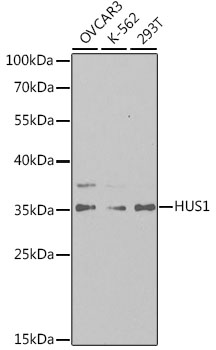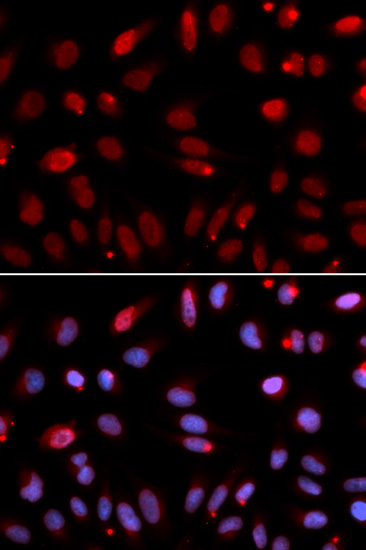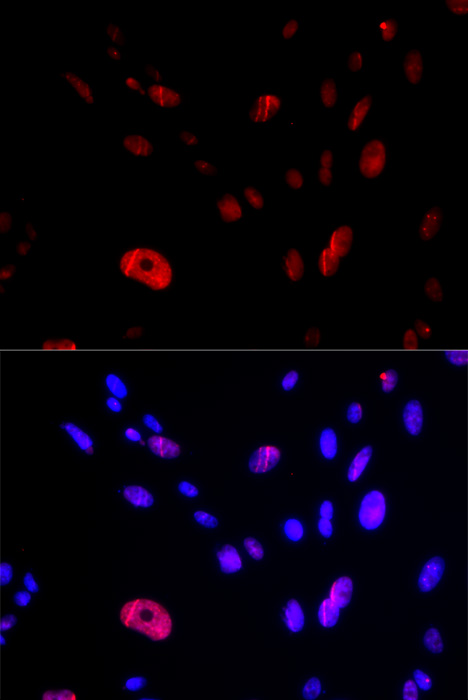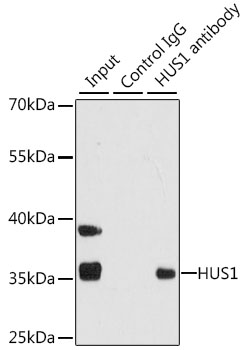-
Product Name
HUS1 Polyclonal Antibody
- Documents
-
Description
Polyclonal antibody to HUS1
-
Tested applications
WB, IF, IP
-
Species reactivity
Human, Mouse
-
Alternative names
HUS1 antibody; hHUS1 antibody; checkpoint protein HUS1 antibody
-
Isotype
Rabbit IgG
-
Preparation
Antigen: Recombinant fusion protein containing a sequence corresponding to amino acids 1-280 of human HUS1 (NP_004498.1).
-
Clonality
Polyclonal
-
Formulation
PBS with 0.02% sodium azide, 50% glycerol, pH7.3.
-
Storage instructions
Store at -20℃. Avoid freeze / thaw cycles.
-
Applications
WB 1:500 - 1:2000
IF 1:50 - 1:100
IP 1:50 - 1:200 -
Validations

Western blot - HUS1 Polyclonal Antibody
Western blot analysis of extracts of various cell lines, using HUS1 antibody at 1:1000 dilution.Secondary antibody: HRP Goat Anti-Rabbit IgG (H+L) at 1:10000 dilution.Lysates/proteins: 25ug per lane.Blocking buffer: 3% nonfat dry milk in TBST.Detection: ECL Basic Kit .Exposure time: 180s.

Immunofluorescence - HUS1 Polyclonal Antibody
Immunofluorescence analysis of U2OS cells using HUS1 antibody . Blue: DAPI for nuclear staining.

Immunofluorescence - HUS1 Polyclonal Antibody
Immunofluorescence analysis of U2OS cells using HUS1 antibody . Blue: DAPI for nuclear staining.

Immunoprecipitation - HUS1 Polyclonal Antibody
Immunoprecipitation analysis of 200ug extracts of 293T cells using 1ug HUS1 antibody . Western blot was performed from the immunoprecipitate using HUS1 antibody at a dilition of 1:1000.
-
Background
Component of the 9-1-1 cell-cycle checkpoint response complex that plays a major role in DNA repair. The 9-1-1 complex is recruited to DNA lesion upon damage by the RAD17-replication factor C (RFC) clamp loader complex. Acts then as a sliding clamp platform on DNA for several proteins involved in long-patch base excision repair (LP-BER). The 9-1-1 complex stimulates DNA polymerase beta (POLB) activity by increasing its affinity for the 3'-OH end of the primer-template and stabilizes POLB to those sites where LP-BER proceeds; endonuclease FEN1 cleavage activity on substrates with double, nick, or gap flaps of distinct sequences and lengths; and DNA ligase I (LIG1) on long-patch base excision repair substrates. The 9-1-1 complex is necessary for the recruitment of RHNO1 to sites of double-stranded breaks (DSB) occurring during the S phase.
Related Products / Services
Please note: All products are "FOR RESEARCH USE ONLY AND ARE NOT INTENDED FOR DIAGNOSTIC OR THERAPEUTIC USE"
